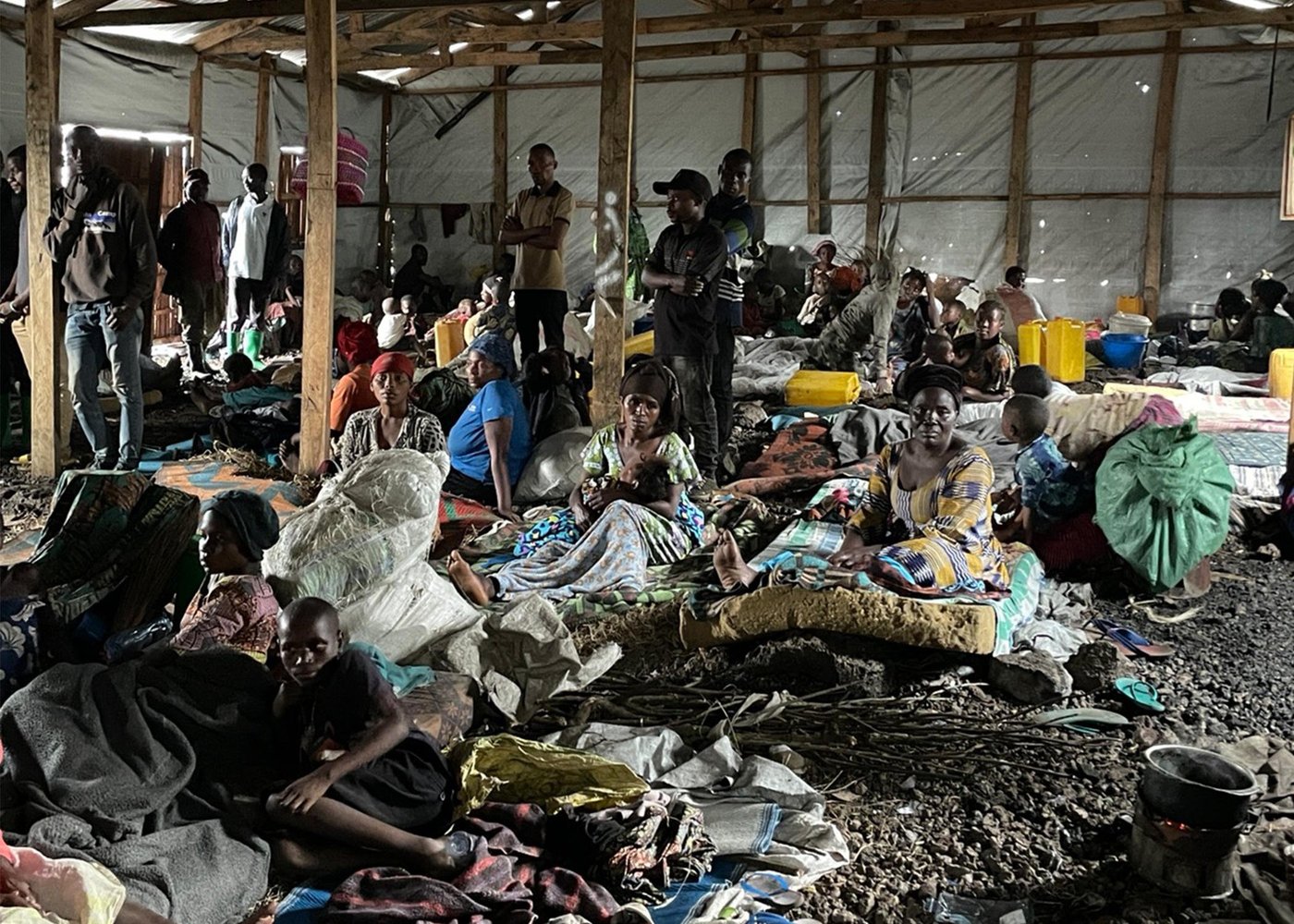
Sandrine and Vianney
Sandrine rushed home after a day’s work in the fields. Her village, to the north of Sake, had been emptied of its inhabitants. The 32-year-old mother of eight heard that a bomb had fallen on the nearby military camp. Sandrine took her children and fled.
“I was only able to carry one pot with my children’s clothes in it and four dollars, which I quickly spent to buy food,” she says.
In recent weeks, fighting has intensified around Sake, a town that until now had escaped the ongoing conflict in Masisi territory. Heavy artillery and mortar fire has been heard throughout the town. Some 135,000 people fled towards Goma in the first week of February alone.
Sandrine arrived in the Rusayo 2 site for displaced people, located to the east of Sake. The young woman has nothing left.
“We’re scared of dying of hunger,” she says. “We also hear gunfire every day. We don’t have anything to eat and the food in the markets is too expensive to buy. We have nowhere to sleep – we had to leave everything behind, including our mattresses.”
Vianney arrived from Kitchanga with his wife and three children. After taking refuge with a family in Sake, this 32-year-old carpenter had to flee the town. He has just been put up in a hangar in Rusayo 2 with 89 other families.
“We didn’t have anything with us when we escaped because transport was too expensive,” he says. “Here, we need to have good relations with the families around us as we share most of the things we need during the day.”
Sign up to our newsletter to read more stories from around the world.

Barely surviving
According to an assessment conducted by the Norwegian Refugee Council (NRC), about 170,000 people have settled in the two sites for displaced people in Rusayo. More than 20,000 of them arrived in the week beginning 12 February.
Crammed into hangars or makeshift shelters, these families lack everything. To feed her children, Sandrine sells firewood that she gathers in the surrounding woods. She earns a meagre sum for each bundle (around USD 0.20), even though this activity could cost her life.
“When we go in the woods, there are soldiers and gunfire every day,” she explains. “A lot of women have been raped. I was attacked less than a week ago while looking for wood with another woman. I still go every day. It’s the only way we can survive.”
While in Sake, Vianney’s wife was responsible for earning money for the family to survive. She would leave every day at 6am to go and look for wood to sell, and would only return at 4pm. Vianney stayed home to look after the children.
“I was afraid to go into the woods myself as there are soldiers that always stop the men and ask for money,” he says. “I also wanted to be home in case humanitarian aid agencies came by to register us. We couldn’t miss that opportunity.”
For now, the whole family is staying in the hangar, and Vianney’s wife still has not been able to start looking for wood. She wants to get to know the area better first.
Access to water is a major problem for the displaced families. According to the World Health Organization, a person must receive a minimum of 15 litres of water per day when in an emergency. The 127,500 people living in the Rusayo 1 site, however, receive a little over 3 litres of water per person daily.
“My wife often queues for up to three hours to be able to access a water tap. But they often hear gunfire, and she ends up coming back empty-handed,” says Vianney.

What lies ahead?
The future of these families depends on how the conflict develops. Vianney hopes to be able to return home and is already thinking about what’s next. “While we wait for the war to finish, we’ll look for places where we can go back to work,” he says. “I could help people rebuild their houses since I’m a carpenter.”
Sandrine, on the other hand, has lost all hope of returning home, and is counting on humanitarian aid to help her rebuild her life. “I would like to leave the site to sleep somewhere else and open a business, but I don’t have the means,” she says. “Here, it’s very difficult. I haven’t received any assistance since I arrived. I was only registered today, more than two months later.”
Stuck in this precarious and dangerous situation, Sandrine cannot send her children to school. “They don't even have any food, how can they study?” she asks. “They stay with me to help collect wood, even though it scares them.”
The international community must act
Since November 2023, clashes have displaced more than one million people across North Kivu. With over 2.5 million internally displaced people in the province, NRC continues to respond to catastrophic levels of needs with insufficient resources.
The international community must step up and provide adequate support for the humanitarian response in North Kivu, as well as the other ongoing crises in eastern DR Congo.
Sign up to our newsletter to read more stories from around the world.


